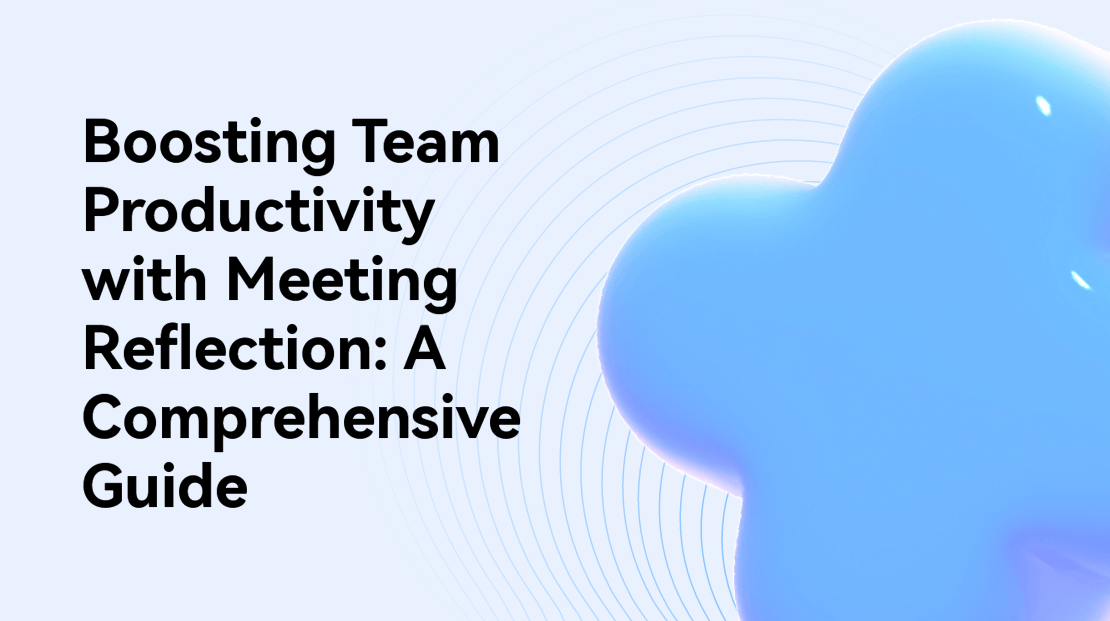Meetings can be done to plan campaigns and initiatives for companies and organizations. In some cases, teams can also conduct a meeting reflection. It's a distinct meeting that allows the organization to assess what went well and incorporate it into future works. At the same time, you'll have the chance to identify the lapses, including the lessons that can be taken from those mishaps.
When the work gets hectic, it's easy to get overwhelmed with the demands of the new task that you won't have the chance to reflect on and learn. Explore more about how a reflection work meeting works by reading through this article.

What is a meeting reflection?
A meeting reflection is usually led by team members who share experiences and stories with the rest of the team. In most cases, a reflection meeting can be used to discuss projects or collaborations during a period. Unlike formal retrospective discussions, a reflection meeting for work is more free-flowing than solution-focused. Those conducting these meetings naturally use questions and conversations to know the lessons the members learned.
The 'learner' will be the one to choose the topic or story, while the rest of the team will serve as listeners who can follow up through a series of questions. The topic can be a specific problem the team solved or a discussion with a client that helped the team understand and resolve issues. These questions are related to their experiences, work, initiatives, and values.
When to use a meeting reflection?
A reflection for a work meeting is useful when your team wants to dig deeper into how teams learn new skills, take note of critical observations, and identify the best practices in building those skills for the future.
You can also conduct a reflection work meeting when the organization wants to provide problem-solving strategies or recommend podcasts, books, series, or movies worth seeking. Most importantly, organizations use this technique to encourage employees at all levels to engage and contribute to each other's professional development.

Benefits of a meeting reflection
A work meeting reflection is a versatile strategy in a team or organization. This means it guarantees positive results to those using it. The following are notable benefits of using this type of meeting.
- Self-awareness. As you know, a meeting reflection promotes an informal and free-flowing conversation between learners and their listeners. This way, the strategy helps members understand and reflect on their inner feelings, which affect specific work aspects.
- A better understanding of the 'why.' Reflection meetings are also helpful to understand the reasons behind each task or the lack of it. Generally, having a purpose will affect team morale and motivation. Research has shown that purpose-driven organizations are more productive.
- Expand one's mindset. Because there are no strict rules to conduct a reflection meeting, most members will be more open and comfortable sharing new ideas and perspectives. As a result, they can adapt and develop innovative solutions to existing and future issues.
- Reflection meeting sessions are excellent for determining alignment issues within the organization.
- Stronger bond. Reflection meetings promote an open work environment with better self-awareness. As a result, better relationships among team members will extend to clients and other stakeholders.

How to run a successful meeting reflection?
Each organization has its own ways and schedules of conducting a reflection meeting; hence, it will be different for every team. The following are guidelines for running an effective reflection for a work meeting.
- Find the proper schedule for the reflection meeting. As much as you want to hold such meetings frequently, there might be times when the frequency will be distracting, and members might not have much to say. With this, it's fitting to determine the type of work your team handles so you can determine the schedule of reflection meetings. For a fast-paced working environment, you can conduct the meetings weekly. Meanwhile, monthly reflection meetings can be for long-term tasks or projects.
- Set the roles for team members. There must be a learner whose task is to share recent experiences, or the lessons learned that they find meaningful. The session must also have a facilitator, timekeeper, and notetaker.
- Start the session with an icebreaker. To have everyone in sync and think creatively, it pays to let members get to know each other. Setting the mood is essential to let everyone feel welcome so, in turn, they can also share helpful inputs as the meeting progresses.
- Let the learner share their recent learnings. While this happens, the listeners can list their observations using sticky notes. The observations must align with the narrative, which can prompt significant follow-up questions.
- Respond with observations, questions, or advice as a group. Let each listener share an insight, observation, or question to give more depth to the story. The more specific the details being shared, the better the insights you'll have. The notetaker will list these insights and ensure the discussion is on track.
- Decide on possible follow-up action plans as a team. The notetaker can provide a summary of the reflection meeting verbally. At the same time, the assigned learner can provide additional details which may have needed to be included. Most importantly, decide with your team if any ideas need a follow-up.
FAQs about the meeting reflection
What are some short inspirational reflections for meetings?
There are a handful of inspirational questions and reflections that can flesh out insights during reflection meetings. You can use some of the ideas and questions below when meeting with your team.
- How did you feel during the situation or moment?
- What should have changed to avoid the experience?
- What accomplishment makes you the proudest?
- What were the top priorities for the company this past year?
- Walk us through the thought process when coming up with that decision.
- What did you expect to achieve, and did it coincide with the outcome?
What is the purpose of a meeting reflection?
The primary goal of a reflection meeting is to help the organization and its members learn as a group by reflecting on recent tasks or experiences while sharing them with others. It nurtures open-mindedness and creativity to ensure there will be insightful ideas coming out from the meeting.
However, in some cases, meeting preparations can be a handful, and adding another regular meeting for the group can be daunting. This is why relying on specific tools that guide reflection meetings is an ideal option. Most organizations today adopt meeting automation to conduct regular reflection meetings with minimal supervision.
Visualize your meeting reflections with an online whiteboard
Online diagramming tools, like Boardmix, provide better collaboration regardless of your team's location. In fact, all you need is a link to a meeting reflection template, and you can share a virtual whiteboard with all your members. Besides the access, creators can authorize their teammates to write and edit their inputs on the whiteboard.
When the learner shares their experiences, listeners can bring in sticky notes to the virtual whiteboard and write their insights. It's an excellent tool that promotes efficient collaboration. The notetaker can save the insights listed on the whiteboard and reopen it during the next reflection meeting session.








